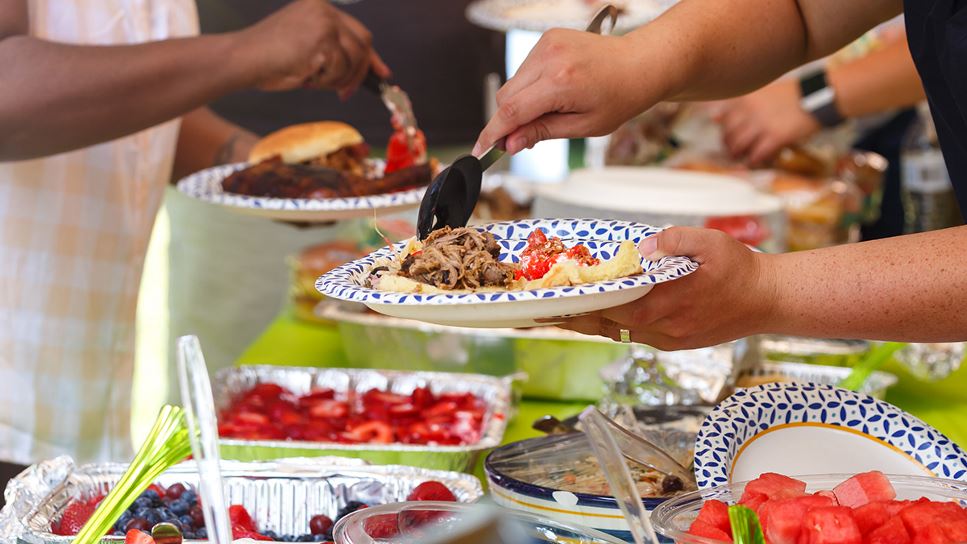Buffet and potluck-style gatherings are a convenient alternative to the traditional sit-down dinner. However, it’s important to take extra care when hosting because foods often sit out for long periods of time while guests snack and socialize, putting them at risk of the buffet blues — otherwise known as food poisoning.
Be the Host with the Most Food Safety Savvy
Lists help keep you organized, such as those for guests and groceries, yet one of the most important lists usually goes unwritten: a food safety checklist. These tips will help keep potluck and buffet meals fresh and safe for your guests to enjoy:
- Keep it clean. Wash your hands before and after handling food, as well as between changing tasks, such as working with raw meat and then switching to produce. Serve food on clean plates and replace serving plates and utensils with clean ones when replenishing items. These steps are helpful in reducing the spread of bacteria and cross-contamination.
- Monitor temperatures. Keep cold dishes cold (below 40°F) and hot dishes hot (above 140°F). When foods stay at a lukewarm temperature, they fall into the danger zone where bacteria multiply more rapidly.
- Always use a food thermometer to check the doneness of cooked foods. The only way to tell if a food is cooked to a safe level of doneness is by using a food thermometer. Make sure your food reaches a safe internal temperature before you serve it.
- Transport food safely when traveling. Whether you’re serving the food you prepared somewhere else or having guests bring individual dishes, safely transporting food is part of the food safety process. Pack cold food items with ice in a well-insulated cooler or other container with cooling packs. In cold weather, transport the cooler in the trunk, which is the coolest part of the car in the wintertime. In warm weather, transport the cooler in an air-conditioned car instead of in a hot trunk. For hot items, pack in a well-insulated container and place them in the warmest part of your car. When you arrive, make sure to reheat foods to a safe internal temperature of 165°F.
- Follow the two-hour rule. Perishable food can grow harmful bacteria quickly when left out of the refrigerator for more than two hours. If the temperature is warm (above 90°F), then the time limit is just one hour. To help avoid this buffet blunder and keep food out of the danger zone, set a kitchen timer as a reminder to place uneaten food back in the refrigerator before the time is up and to refresh your buffet table with new favorites every one to two hours. Any food left out beyond that time frame should be discarded. If guests are bringing food, keep in mind that the clock starts ticking when they walk out their door to come over.
- Store hot foods in shallow containers to refrigerate or freeze them. This promotes rapid, even cooling throughout the food.
Don't Let These Bacteria Crash Your Get-Together
Bacteria is everywhere and can pass easily from hands to food. Keep Staphylococcus aureus, Clostridium perfringens and Listeria monocytogenes away from your buffets.
Staphylococcus aureus
Staphylococcus ("staph") bacteria may live on the skin of healthy people without ever causing them to get sick but can spread and make other people ill through improper food handling. Prevention includes washing hands and utensils before handling food and not letting prepared foods — including cured meats and salads such as ham, egg, tuna, chicken, potato and pasta — sit at room temperature for more than two hours, or one hour if it’s warmer than 90°F.
Clostridium perfringens
C. perfringens is often found in raw meat and poultry, as well as foods served in large quantities and left at room temperature for long periods of time, for example buffets. To reduce risk, divide large portions of cooked foods such as beef, turkey, gravy, dressing, stews and casseroles into smaller portions for serving and cooling. Be sure to keep hot foods hot (above 140°F) and cold foods cold (below 40°F).
Listeria monocytogenes
Listeria bacteria can continue to multiply during refrigeration, which puts foods typically served cold at risk. Some foods that are already cooked, such as hot dogs and deli meat should be reheated to 165°F before serving, particularly for individuals at high risk for foodborne illness. Stick with pasteurized dairy and milk products and keep the raw sprouts off the table, as these also come with a higher risk for Listeria.
References
Find a Nutrition Expert
Looking for credible nutrition information and recommendations? The Academy of Nutrition and Dietetics' network of credentialed food and nutrition practitioners are ready to help!

